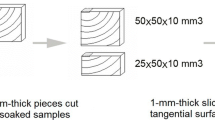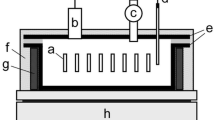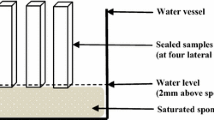Abstract
Effect of artificial weathering on the wettability of three heat-treated North American wood species (jack pine, aspen, and birch) is studied from the point of view of the structural and chemical changes taking place on the wood surface. Weathering increases wettability of all three heat-treated woods by water. Changes in wettability during artificial weathering differ according to heat treatment procedure and wood species and are likely due to combination of structural and chemical changes of the surfaces. Scanning electron microscopic analysis indicates that cracks form due to degradation taking place during weathering. As a result, water has easier entry into the cell wall, which consequently increases wettability. IR spectra suggest that the OH/CH2 ratio for heat-treated specimens is inversely proportional to the contact angle regardless of the type of wood species. The presence of cellulose-rich layer on wood surface and increasing amount of amorphous cellulose transformed from crystallized cellulose due to weathering result in increase in hydroxyl; consequently, it increases heat-treated wood wettability.











Similar content being viewed by others
References
Aydemir D, Gunduz G, Altuntaş E, Ertas M, Turgut Şahin H, Hakki Alma M (2011) Investigating changes in the chemical constituents and dimensional stability of heat-treated hornbeam and uludag fir wood. BioResources 6(2):1308–1321
Banks WB (1973) Water uptake by scots pine sapwood, and its restriction by the use of water repellents. Wood Sci Technol 7(4):271–284
Boonstra MJ, Rijsdijk JF, Sander C, Kegel E, Tjeerdsma B, Militz H, Van Acker J, Stevens M (2006) Microstructural and physical aspects of heat treated wood. Part 1. Softwoods. Maderas Ciencia y Tecnologia 8(3):193–208
Brosse N, El Hage R, Chaouch M, Pétrissans M, Dumarçay S, Gérardin P (2010) Investigation of the chemical modifications of beech wood lignin during heat treatment. Polym Degrad Stab 95(9):1721–1726
Caulfield DF (1978) The effect of cellulose on the structure of water. Fiber-water interactions in paper-making, p 63
Colom X, Carrillo F, Nogués F, Garriga P (2003) Structural analysis of photodegraded wood by means of FTIR spectroscopy. Polym Degrad Stab 80(3):543–549
de Moura LF, Hernández RE (2005) Evaluation of varnish coating performance for two surfacing methods on sugar maple wood. Wood Fiber Sci 37(2):355–366
De Moura LF, Hernández RE (2006) Effects of abrasive mineral, grit size and feed speed on the quality of sanded surfaces of sugar maple wood. Wood Sci Technol 40(6):517–530
Duchez L, Herri JM, Guyonnet R (2001) Modelling of a wood retification furnature proceedings of 8th francophone congres in engineering proceeds, pp 61–68
Esteves BM, Pereira HM (2009) Wood modification by heat treatment: a review. BioResources 4(1):370–404
Evans PD (1989) Structural changes in Pinus radiata during weathering. J Inst Wood Sci 11(5):172–181
Evans PD, Thay PD, Schmalzl KJ (1996) Degradation of wood surfaces during natural weathering. Effects on lignin and cellulose and on the adhesion of acrylic latex primers. Wood Sci Technol 30(6):411–422
Feist WC, Hon DNS (1984) Chemistry of weathering and protection. In: Rowell RM (ed) The chemistry of solid wood. American Chemical Society, pp 401–451
Gindl M, Reiterer A, Sinn G, Stanzl-Tschegg SE (2004) Effects of surface ageing on wettability, surface chemistry, and adhesion of wood. Holz Roh-Werkst 62(4):273–280
Gindl M, Sinn G, Stanzl-Tschegg SE (2006) The effects of ultraviolet light exposure on the wetting properties of wood. J Adhes Sci Technol 20(8):817–828
Hakkou M, Pétrissans M, El Bakali I, Gérardin P, Zoulalian A (2005a) Wettability changes and mass loss during heat treatment of wood. Holzforschung 59(1):35–37
Hakkou M, Pétrissans M, Zoulalian A, Gerardin P (2005b) Investigation of wood wettability changes during heat treatment on the basis of chemical analysis. Polym Degrad Stab 89(1):1–5
Hon DNS (1981) Weathering of wood in structural use. In: Environmental degradation of engineering in aggressive environments. Proceedings of 2nd international conference on environmental degradation of engineering materials. Va Polytech Inst, Lab for the Study of Environ Degrad of Eng Mater, Blacksburg, Va, USA, pp 519–529, 518
Hon DNS (1984) ESCA study of oxidized wood surfaces. J Appl Polym Sci 29(9):2777–2784
Hon DNS (1985) Weathering reactions of lignocellulose materials. In: Polymer 85: an international symposium on characterization and analysis of polymers—preprints. Royal Australian Chemical Inst, Polymer Div, p 373
Hon DNS, Chang S-T (1984) Surface degradation of wood by ultraviolet light. J Polym Sci Part A-1 Polym Chem 22(9):2227–2241
Hon DNS, Feist WC (1986) Weathering characteristics of hardwood surfaces. Wood Sci Technol 20(2):169–183
Hon DNS, Ifju G (1978) Measuring penetration of light into wood by detection of photo-induced free radicals. Wood Sci 11(2):118–127
Hon DN-S, Minemura N (1991) Color and discoloration. In: Hon DN-S, Shiraishi N (eds) Wood and cellulosic chemistry. Marcel Dekker, New York, pp 525–555
Horn BA, Qiu J, Owen NL, Feist WC (1992) FT-IR studies of weathering effects in western red cedar and southern pine: chemical modification of lignocellulosics. FRI Bull 176:67–76
Jin T, Kang CW, Lee NH, Kang HY, Matsumura J (2011) Changes in the color and physical properties of wood by high temperature heat treatment. J Fac Agric Kyushu Univ 56(1):129–137
Kalnins MA, Feist WC (1993) Increase in wettability of wood with weathering. For Prod J 43(2):55
Kang H-Y, Park S-J, Kim Y-S (2002) Moisture sorption and ultrasonic velocity of artificially weathered spruce. Mokchae Konghak 30(1):18–24
Kataoka Y, Kiguchi M (2001) Depth profiling of photo-induced degradation in wood by FT-IR microspectroscopy. J Wood Sci 47(4):325–327
Kishino M, Nakano T (2004a) Artificial weathering of tropical woods. Part 1: changes in wettability. Holzforschung 58(5):552–557
Kishino M, Nakano T (2004b) Artificial weathering of tropical woods. Part 2: color change. Holzforschung 58(5):558–565
Kocaefe D, Poncsak S, Boluk Y (2008a) Effect of thermal treatment on the chemical composition and mechanical properties of birch and aspen. BioResources 3(2):517–537
Kocaefe D, Poncsak S, Dore G, Younsi R (2008b) Effect of heat treatment on the wettability of white ash and soft maple by water. Holz Roh-Werkst 66(5):355–361
Kocaefe D, Shi JL, Yang DQ, Bouazara M (2008c) Mechanical properties, dimensional stability, and mold resistance of heat-treated jack pine and aspen. For Prod J 58(6):88–93
Li XJ, Cai ZY, Mou QY, Wu YQ, Liu Y (2011) Effects of heat treatment on some physical properties of Douglas fir (Pseudotsuga menziesii) wood. Adv Mater Res 197–198:90–95
Mburu F, Dumarçay S, Huber F, Petrissans M, Gérardin P (2007) Evaluation of thermally modified Grevillea robusta heartwood as an alternative to shortage of wood resource in Kenya: characterisation of physicochemical properties and improvement of bio-resistance. Bioresour Technol 98(18):3478–3486. doi:10.1016/j.biortech.2006.11.006
Miniutti VP (1964) Microscale changes in cell structure at softwood surfaces during weathering. For Prod J 14(12):571–576
Miniutti VP (1967) Microscopic observations of ultraviolet irradiated and weathered softwood surfaces and clear coatings. US For Serv Res Paper FPL 74:1–32
Miniutti VP (1973) Contraction in softwood surfaces during ultraviolet irradiation and weathering. J Paint Technol 45(577):27–34
Nelson ML, O’Connor RT (1964) Relation of certain infrared bands to cellulose crystallinity and crystal lattice type. Part II. A new infrared ratio for estimation of crystallinity in cellulose I and II. J Appl Polym Sci 8:1325–1341
Nguyen T, Johns WE (1979) The effects of aging and extraction on the surface free energy of Douglas fir and redwood. Wood Sci Technol 13(1):29–40
Nuopponen M, Wikberg H, Vuorinen T, Maunu SL, Jämsä S, Viitaniemi P (2004) Heat-treated softwood exposed to weathering. J Appl Polym Sci 91(4):2128–2134
Paajanen LM (1994) Structural changes in primed Scots pine and Norway spruce during weathering. Materiaux et Constr 27(168):237–244
Pandey KK (1999) A study of chemical structure of soft and hardwood and wood polymers by FTIR spectroscopy. J Appl Polym Sci 71(12):1969–1975
Park BS, Furuno T, Uehara T (1996) Histochemical changes of wood surfaces irradiated with ultraviolet light. Mokuzai Gakkaishi/J Jpn Wood Res Soc 42(1):1–9
Patton TC (1970) Simplified review of adhesion theory based on surface energetics. Tappi 53(3):421–429
Pavlo B, Niemz P (2003) Effect of temperature on color and strength of spruce wood. Holzforschung 12:539–546
Pétrissans M, Gérardin P, El Bakali I, Serraj M (2003) Wettability of heat-treated wood. Holzforschung 57(3):301–307
Salmén L, Possler H, Stevanic JS, Stanzl-Tschegg SE (2008) Analysis of thermally treated wood samples using dynamic FT-IR-spectroscopy. Holzforschung 62(6):676–678
Shi Q, Bao FC, Lu JX, Jiang JH (2011) Effect of heat treatment temperature on the color of okan wood. Adv Mater Res 214:531–534
Skaar C (1984) Wood-water relationships. Chem Solid Wood Adv Chem 207:127–172
Stamm AJ (1964) Selective adsorption from solution. In: Stamm AJ (ed) Wood and cellulose science. Ronald Press Co., pp 175–185
Stamm AJ, Loughborough WK (1942) Variation in shrinking and swelling of wood. Trans Am Soc Mech Eng 64:379–386
Sumi Y, Hale RR, Meyer JA, Leopold AB, Ranby BG (1964) Accessibility of wood and wood carbohydrates measured with tritiated water. Tappi J 47(10):621–624
Temiz A, Terziev N, Eikenes M, Hafren J (2007) Effect of accelerated weathering on surface chemistry of modified wood. Appl Surf Sci 253(12):5355–5362
Tolvaj L, Faix O (1995) Artificial ageing of wood monitored by DRIFT spectroscopy and CIE L*a*b* color measurements. Holzforschung 49(5):397–404
Tumen I, Aydemir D, Gunduz G, Uner B, Cetin H (2010) Changes in the chemical structure of thermally treated wood. BioResources 5(3):1936–1944
Wang SY, Lin SJ (1991) The effect of outdoor environmental exposure on the main component of woods. Mokuzai Gakkaishi 37(10):954–963
Wang S, Zhang Y, Xing C (2007) Effect of drying method on the surface wettability of wood strands. Holz Roh-Werkst 65(6):437–442
Weiland JJ, Guyonnet R (2003) Study of chemical modifications and fungi degradation of thermally modified wood using DRIFT spectroscopy. Holz Roh-Werkst 61(3):216–220
Windeisen E, Strobel C, Wegener G (2007) Chemical changes during the production of thermo-treated beech wood. Wood Sci Technol 41(6):523–536
Acknowledgments
The authors thank Fonds québécois de la recherche sur la nature et les technologies (FQRNT), Développement Économique Canada (DEC), Ministère du Développement Économique, de l’Innovation et de l’Exportation (MDEIE), Conférence Régionale des Élus du Saguenay-Lac-St-Jean (CRÉ), Université du Québec à Chicoutimi (UQAC), Fondation de l’Université du Québec à Chicoutimi (FUQAC), FPInnovation, Alberta Innovates, and industrial partners (PCI Ind., Ohlin Thermotech, Kisis Technology, and Industries ISA) for their technical and financial contributions as well as Centre universitaire de recherche sur l’aluminium (CURAL) for valuable assistance and technical support during SEM tests.
Author information
Authors and Affiliations
Corresponding author
Rights and permissions
About this article
Cite this article
Huang, X., Kocaefe, D., Kocaefe, Y. et al. Changes in wettability of heat-treated wood due to artificial weathering. Wood Sci Technol 46, 1215–1237 (2012). https://doi.org/10.1007/s00226-012-0479-6
Received:
Published:
Issue Date:
DOI: https://doi.org/10.1007/s00226-012-0479-6




